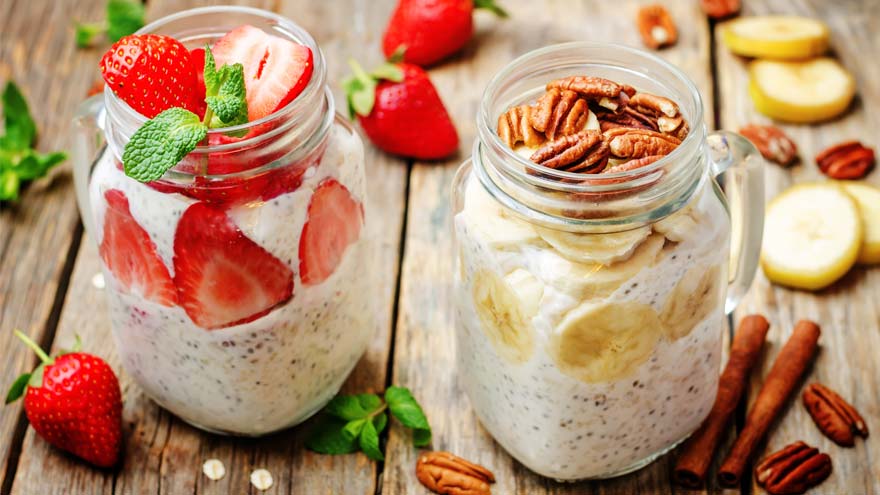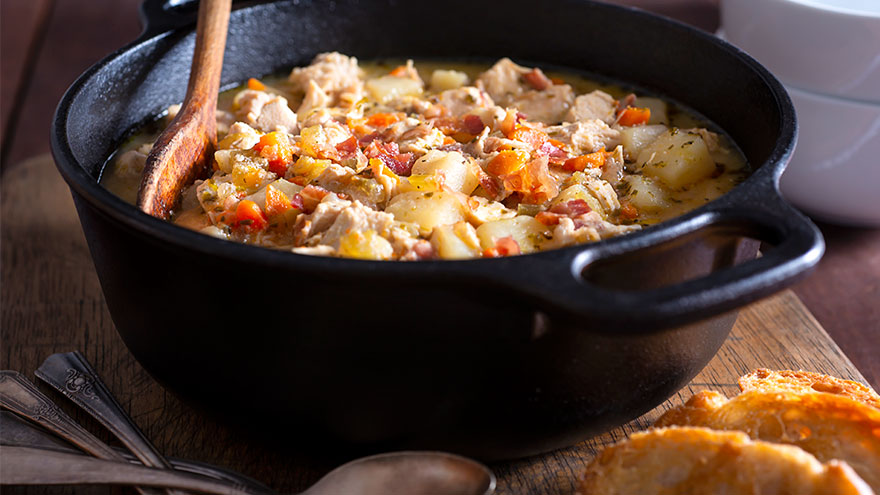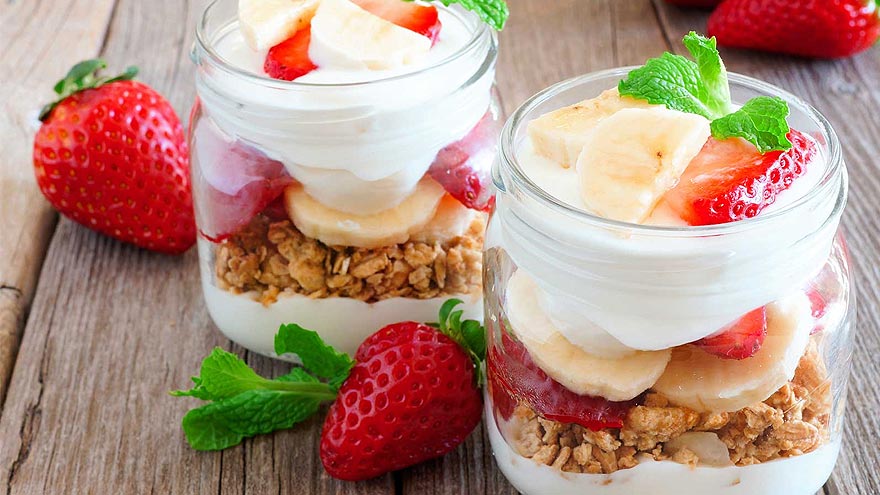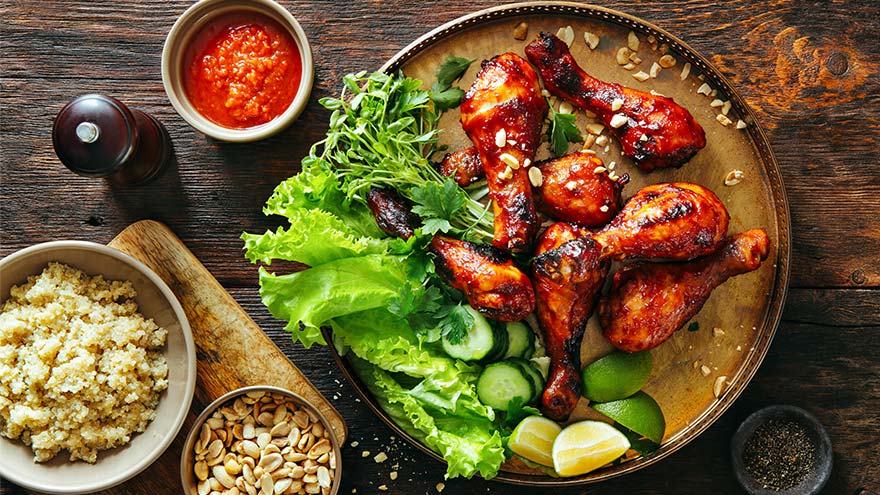Search
-
Make Your Own Trail Mix: 4 Quick and Easy Recipes
Craving a crunchy, sweet, and nutritious snack? Try making your own trail mix! Perfect blends of nuts, dried fruits, and a touch of chocolate can be whipped up using bulk bin ingredients or pantry staples. Enjoy this delicious, healthy snack on a hike, at the office, or on your next road trip through Nevada's scenic deserts.
Read More About Make Your Own Trail Mix: 4 Quick and Easy Recipes
-
Nourishing Your Loved One Through Cancer Treatment
Eating healthy is a daily challenge for many, but for those with cancer, it is an even harder struggle. A cancer diagnosis affects not only those diagnosed but family members and friends, too. One key area of concern is making sure your loved one stays well by eating healthy food every day. Here are some vital cancer nutrition tips from Jessica Blauenstein, a Board Certified Specialist in Oncology Nutrition and Registered Dietitian at Renown Health. Help to Prepare Meals and Snacks for Daily Cancer Nutrition Make it grab and go. Easy-to-make meals help reduce the burden of having to cook and prepare food. Having easy to grab snacks on the counter or in the fridge can help ensure your loved one has access to those nutrients when needed. Sit outside of the kitchen. This allows your loved one to avoid cooking smells which can make them feel sick as a side effect of cancer treatments. Also try serving them cold foods such as sandwiches, cheese and crackers, or shakes which have a mild scent. Try drinkable meals. Some people with cancer find it easier to sip their calories over the course of 30 minutes to an hour. Consider smoothies or supplemental shakes such as Ensure Complete, Fairlife shakes, Orgain shakes, or Boost Plus to name a few. A great foundation for a smoothie is a protein source (Greek yogurt, protein powder, nut butters or milk) with a carbohydrate (fruits, juice or berries). Add other ingredients as desired, such as spinach, kale, and ground flaxseed or chia seeds to give it more vitamins, minerals, and fiber. Snack Ideas for Those Undergoing Cancer Treatment The following ideas are both quick and easy to make for your loved one. Chicken or tuna salad with whole grain crackers or as a sandwich on whole grain bread Greek yogurt mixed with cereal, fruit and/or nuts Cottage cheese with banana, cinnamon and/or peanut butter Favorite fruit with 100% natural peanut or almond butter spread - Try peanut butter with bananas, apples, or even celery Their favorite veggies dipped in a salad dressing of your choice - For example, carrots with hummus, tahini, or ranch dressing Cheese and whole grain crackers - Add tomato slices with a small amount of avocado, and a dash of oregano on top for more flavor Eggs scrambled with cheese, vegetables and/or salsa Peanut butter and jelly sandwich on whole grain bread A baked sweet potato with some favorite toppings Hard boiled eggs and/or egg salad with whole grain crackers, or as a sandwich on whole grain bread Oatmeal or cream of wheat prepared with milk, fruit and/or nuts Sometimes your loved one may not feel like eating or refuse to eat. If treatment side effects are impacting your loved one’s ability to eat, please visit the websites below containing recipes tailored to treat side effects. Cook for Your Life ELLICSR Of course, you may also consult a registered dietitian and/or the patients care team, if you have more cancer nutrition concerns.
Read More About Nourishing Your Loved One Through Cancer Treatment
-
Healthy Potato Salad A Creamy Dreamy and Light Picnic Favorite
Potato salad is the superstar of summer picnics, a delightful sidekick at backyard BBQs, and a tasty everyday treat! Our friends at Renown's Health Improvement Programs whipped up a fabulous, health-conscious version that doesn't skimp on the creamy dreaminess we crave. This salad features purple potatoes for a dash of delightful color. It's also easy to make, with protein-rich Greek yogurt and egg whites. This simple but classic dish will indeed become your circle's new favorite—talk about a tasty transformation!
Read More About Healthy Potato Salad A Creamy Dreamy and Light Picnic Favorite
-
Why Is My Hair Falling Out? Alopecia Explained
© MikeSaran via Canva.com Hair is often considered a symbol of identity and self-expression, from scalps and eyebrows to beards and bodies. But what happens when this symbol starts to fall out? The 6.7 million people across the country living with alopecia know this feeling all too well. Alopecia, or hair loss, is a medical condition with variable causes, presentations and treatments. Experts at Renown Health dive into the world of alopecia, its causes and how to address it – especially as we embrace National Alopecia Awareness Month this September. Types of Alopecia The term “alopecia” is a broad umbrella term that encompasses many different forms of hair loss that can present itself at any age, no matter your gender or ethnicity. The most common types include: Alopecia Areata: An autoimmune disorder where the immune system targets hair follicles, typically resulting in patches of hair loss on the scalp and/or other body parts. More severe forms of alopecia areata also exist, such as alopecia totalis and alopecia universalis. Androgenetic (or Androgenic) Alopecia: A disorder also known as male or female pattern baldness that causes gradual hair thinning and loss often around the temples and crown. Unlike alopecia areata, this form of alopecia is usually hereditary. Telogen Effluvium: A condition resulting in hair shedding, typically after high-stress or infectious events, such as after giving birth or after a COVID-19 infection. This usually resolves itself within a few months to a year. Traction Alopecia: Hair loss resulting from the effects of tight braiding or styling of the hair, which can cause permanent loss over time. Scarring and Inflammation-Mediated Hair Loss: Patterns of hair loss related to lupus, lichen planus or other autoimmune conditions that can unfortunately be permanent and progressive. Options to Treat Alopecia While there isn’t a cure for most types of alopecia, some treatments are available to help minimize the effects of the condition and promote hair growth. Treatment varies depending on the type of alopecia. Potential options can include: Topical Minoxidil: An FDA-approved over-the-counter medication available in foam or liquid form and applied directly to the scalp, which helps stimulate hair growth by increasing blood flow to hair follicles. Hormone Therapies: A hormone regimen that can help minimize the resulting hair thinning and balding. Corticosteroids: A topical cream or ointment – or an injection for severe cases – that help reduce inflammation and re-grow hair. Low-Level Laser Therapy: A therapeutic, non-invasive intervention involving wearing special caps or combs that release painless, low-level lasers to stimulate hair follicles. Healthy Diets and Nutritional Supplements: A diet rich in vitamins and minerals essential for hair health, such as biotin and collagen, can aid in recovery. Vitamin D and iron are also important hair growth nutrients. Stress Management: Stress can impact the speed and frequency of hair loss. Managing your stress can help mitigate the effects of alopecia. Treatment for alopecia is not a one-size-fits-all approach. A scalp skin biopsy may help determine a cause for hair loss and help guide the best management strategies with your provider. Addressing the Emotional Impacts Even though alopecia isn’t life-threatening, the impacts of the condition can affect your self-esteem and self-image. The most powerful tool to help you manage alopecia is knowledge. Keeping yourself educated about your condition, and encouraging your loved ones to do the same, can help arm yourself with the acceptance and self-compassion you need and help combat misconceptions. With the rise in awareness in the mainstream media for alopecia and other hair conditions, beauty standards and fashion are shifting to become more inclusive for those experiencing hair loss. Celebrating the many diverse hairstyles and fashion statements can help you regain your confidence. There are many options you can advantage of to help style your hair and protect your scalp: Hairpieces: Wigs, extensions and other hairpieces can help cover up balding or thinning patches and add volume to your hair. Hairpieces have come a long way in the past few decades, and many use real human hair. Hats: Hats serve a dual purpose – a fun fashion accessory to help boost your confidence and a method of protecting your scalp from the sun. As someone with alopecia, your scalp is more exposed, and hats can provide that extra layer of protection you need. Scalp Sunscreens: While regular body sunscreens can provide good scalp sun protection, they can result in oily scalp and hair appearance. Sunscreens that are specifically designed for the scalp are available at most beauty stores or online. Remember, patience is fundamental, as many treatments require consistent use over time to see noticeable results. Stay resilient, and don’t give up – you are not alone in your alopecia journey.
Read More About Why Is My Hair Falling Out? Alopecia Explained
-
Crustless Quiche Muffins
Are you looking for a new recipe to add to your healthy brunch menu without all the hassle? This muffin is perfect for hosting or keeping in your refrigerator and reheating whenever you need a protein-packed snack. Now, aren't eggs high in cholesterol? According to the American Heart Association, egg whites provide plenty of protein without the yolk's cholesterol. That's why our dietitian masters a lower-cholesterol egg muffin by combining eggs with an egg white substitute.
-
Easy Overnight Oatmeal
Organize your morning meal the night before with this easy, refrigerated, ready-to-go recipe. Fiber-rich oats are full of omega-3 fatty acids, folate, and potassium and can lower LDL (or bad) cholesterol levels and help keep arteries clear. Start your day the heart-healthy way!
-
Slow Cooker Chicken Potato Soup
A warm, comforting bowl of soup is always perfect for a winter meal. The creamy potatoes, tender chicken and vegetables in this recipe will make this a unique favorite. Even better – you can prep this gluten-free recipe in your slow cooker and freeze the leftovers.
-
Top Safe Sleep Tips for Your Baby
Becoming a parent for the first time means lots of new unknowns – from learning to breastfeed and swaddle to buckling your newborn into the car seat for the first time. But when it comes to putting them to bed safely, it’s important to remember it really can mean life or death. It’s something we’re taught before our little one is even here: the correct way to put your baby to bed safely. Sadly though, the number of infant deaths continues to climb. The main culprit of sleep-related infant death continues to be all the items parents leave in the crib with their babies. According to the Center for Disease Control and Prevention, there are about 3,500 sleep-related deaths among babies each year. “The best advice is ‘bare is best.’ Keep your infant’s sleep space clutter free – no blankets, bumpers, toys or pillows,” said Karen Wagner, Pediatric Nurse Practitioner. Follow the ABCs for Safe Sleep Remembering the ABCs is an easy way to remember how to put your little one to bed safely. A: Alone No blankets, toys or pillows. “We do recommend using a sleep sack as a blanket alternative,” said Karen. “It prevents the risk of suffocation and keeps your baby warm.” Keep in mind, the greatest risk for suffocation happens when babies are under 1 year of age, so it’s best to save the toys, blankets and pillows for their “big kid bed,” or around 18 months old. B: Back The slogan “back is best” is another good reminder. Keeping your baby on their back until they’re old enough to rollover helps reduce the risk of Sudden Infant Death Syndrome (SIDS). C: Crib It is best to have your baby sleep alone in their crib. While co-sleeping may be enticing, especially after a late-night feed, it increases the risks of possible suffocation. However, “having your child in your room, in their own crib or bassinet, is protective for SIDS,” Karen said. “In fact, we think co-rooming reduces SIDS risk by almost 50 percent.” Co-rooming allows parents to keep new babies in close reach and helps parents oversee their baby’s sleep, just in case something happens.
-
Berrylicious Parfait
Treat yourself and your family to this tasty delight on those busy pre-holiday mornings. Super quick to make, this light berry parfait is naturally sweet, packed with protein and texture, and has less than 300 calories!
-
Sweet and Tangy Chipotle Chicken
If you have 5 minutes and a blender, you have homemade marinade! This simple and quick grilled chipotle chicken recipe packs a smoky punch, complemented by the sweet and tangy flavors of honey and lime. Simply marinate and grill for an easy summer weeknight meal.
-
Gourmet Campfire S’mores
In honor of National S'mores Day, August 10, let's celebrate by making these toasty campfire s'mores with some scrumptious gourmet options! Please make sure an adult tends to the fire at all times.
-
Summer Buddha Bowl
Say Hello to Summer in a Bowl If you've wanted to add a healthy new dish to your recipe repertoire, now's the time. This tasty vegan bowl loaded with turmeric chickpeas, marinated tofu, and quinoa is the perfect summer addition.











